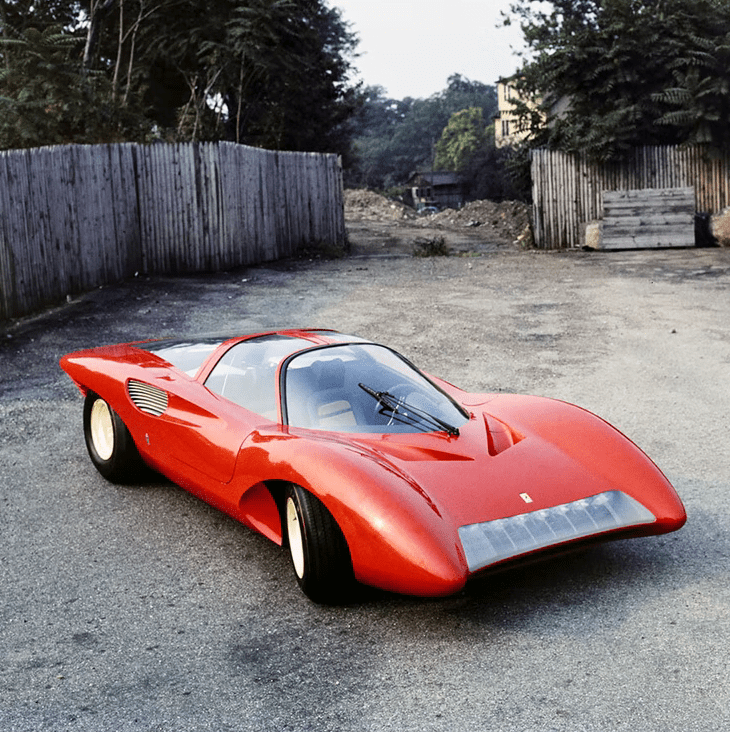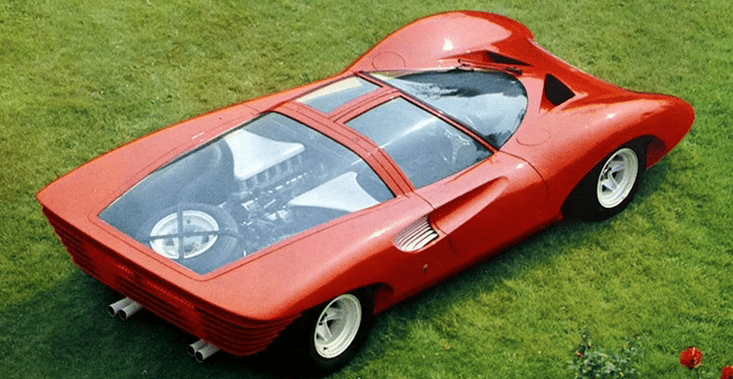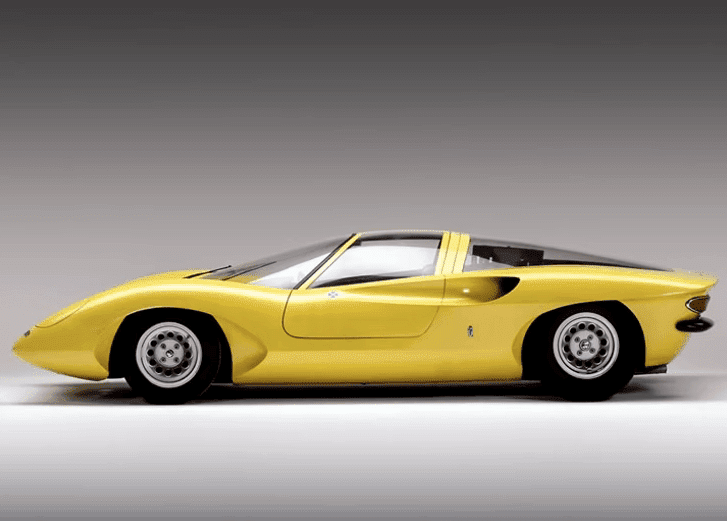Every Ferrari is special in its own way, whether it is the Ferrari that started it all, the 125 S, or the newly revealed Ferrari Daytona SP3.
Whatever the car is, if it has a prancing horse logo slapped on the side of it, you know It’s something remarkable. Although, when we learn about the one-off, the only standing, the extra-rare, the whopping expensive, and the concept Ferrari’s, it is a whole other topic. Those pieces of moving art separate themselves from your “day-to-day” Ferrari, because these aren’t cars you see on the road when you’re heading to your local mall. All companies and manufacturers create concept cars made to portray new styling and technology that will be used on future models. If you are a car enthusiast you must know the infamous wedge Lancia Stratos Zero concept or even the Mercedes C111, concept cars bring new and never-before-seen ideas and designs to the car industry. They inspire artists, designers, ad engineers to think out of the box, and some of these cars are the epitome of “thinking out of the box”.
Sometimes we see the design and technology that was sported on these concept cars, on the roads. Evidently, not in the extent that the concept cars were designed as, but the point of them in the first place was to foreshadow what their company was looking forward to next, how their future cars would look and perform, and what the customers should look out for and expect in the near future. Occasionally you will see the concept designs or technology make it to the road, ofttimes we just see these beautiful unique machines locked away in storage never to be seen by the world again. Their whole existence has been to just show off their looks, not to be touched or driven, and at the end of the day their shape, design, and technology weren’t even used. And there’s one Ferrari that is in that exact position.
Pininfarina and Ferrari’s partnership over the decades has been one of the most successful coach-building and company duo in the automotive world since the coach-building brand caught Enzo Ferrari’s eyes back in 1952. Between the years 1965 and 1970, Pininfarina built and designed a series of insane-looking concept cars based on Ferrari sports racing chassis that the company had an abundant amount of. Around this time, race cars like the stunning Ferrari 330 P4 and 412 P were dominating and tearing up the racing game. These curvaceous and swooping race cars would turn heads anywhere, and not just because of their loud V12 and racing fame. Their elongated bodies, swooping lines, and curvaceous fenders that would dip and rise would make even Ford themselves drool over. Since Ferrari had a surplus of these 60s prototype racing chassis, they put Pininfarina to the task to create a handful of concept cars.
This led to the dazzling Ferrari 250 P5. The Ferrari 250 P5 was a concept car built by Pininfarina, and it was not built to go on the road. It was unveiled at the Geneva Motor Show in 1968, it was revealed alongside a lot of the Dino concepts, like the Dino 206 Berlinetta Speciale and Dino 206 Competizione. Pininfarina had a lot of work cut out for them since they had to top the jaw-dropping 365 P Berlinetta Speciale and a long wheelbase 250 LM Stradale that started off the concept era in 1965. And as always, they exceeded everyone’s expectations.
The 250 P5 was never intended for production and for it to reach roads, the car that looks like it just came from space was just meant to cause a disruption in the car world, and it did just that. Down to its fragile curvy fenders to the long clear engine cover that boasts that three-liter Formula 1 engine, this car looked like it was pulled straight from a sci-fi novel. You’ll notice that the front nose of the car looks like a McLaren race car from the 1960s, one thing it doesn’t have is your traditional’ headlights, but instead has a strip of light that splits those two bulbous wheel arches. It’s wide and flat, just like the prancing horse race cars from the mid-60s. Its elongated rear end is what will get you talking. Those curved side strakes are plastered on the rear, the same strakes on the Ferrari Testarossa and the new Daytona Sp3. The 250 P5 never made it into production, but a handful of its design elements have.
The 365 GTB/4 or mostly known as the “Ferrari Daytona” also mimics the full-width headlights in the Competizione version. The 250 P5 is an untold story, an incognito car, and a story that is hidden away, and many people don’t know that a lot of their favorite designs came from this one concept.
The Ferrari Pininfarina 250 P5 was built on a Dino 206 S chassis, a prototype 60s race car of the time. There is a significant story behind the chassis, chassis 020 went through a handful of changes. The Dino 206 S race cars were solely created to be light and agile cars with a small V6 engine mounted in the middle of them. Dino or Alfredo Ferrari, Enzo Ferrari’s son, was always an advocate for using small engines in race cars, after his death, the Dino marque was in action. Ferrari’s under the name Dino would compete in some of the most infamous and well-known races across the world, and chassis 020 was one of them until it was modified to handle a two-liter Flat 12 engine. After its change and upgrade, chassis 020 was then renamed chassis 0862. It was no longer a 6-cylinder race car, it was a flat-12 monster that was unleaded on Hill climb races until it was abandoned and loaned to Pininfarina.
These types of chassis foreshadowed Ferrari racing prototypes in the 1970s because these certain chassis were essentially Formula 1 type semi-monocoques. They were constructed of lightweight tubular steel framework, aluminum, and fiberglass panels that were riveted in place by countless screws and bolts. Its lightweight body and powerful Italian engine were a match made in Heaven, its power-to-weight ratio let these race cars be thrown into corners easily, which gained them seconds at circuits with numerous corners and hill climbs. The suspension on the 250 P5 was independent all the way around, as well as the disc brakes. Anti-roll bars were added, and it also had uneven wishbones, coil springs, and telescopic Koni shocks.
After the slender and sleek styling, its engine is what follows behind in importance. Ferrari supplied Pininfarina with a “fake” Formula 1 engine for the 250 P5. It had dual overhead camshafts with three valves per cylinder, twin plug ignition, and was fuel-injected instead of being carburated. It was an all-alloy 60° V12 that had a total output of 390bhp at 10,500rpm. For 1968, and for being a concept car, that was more than enough power. Its high-revving engine and contemporary design can be released today, and people will think it’s a brand-new supercar with a state-of-the-art design. Its cut-away dramatic haunches and pontoon-style fenders just scream at you as its slender lines and thin nose make this car look soothing and clean. It is a timeless machine that indirectly helped Ferrari design and create the cars that we know and love today.
When you step inside the 250 P5, you notice that almost everything is done up in black vinyl. The reclined seats, the dashboard, even the gearbox cover. And to remind you what this car is, the center of the seats wear a bright red color. The wide side sills give you that race car feel, as the simple gauge cluster reminds you of later Ferrari cars. The 250 P5 was right-hand drive with a left-hand open gated gear shift, as all Dino prototype cars were. It was as beautiful as it was on the outside, on the inside. Every detail was paid attention to, the lines flow in unison on this car, there is no bad angle on this concept, it does not matter if you are looking at the rear or the front, you can’t deny the beauty of this Italian car. Sadly, all things must come to an end, and the significance of this concept didn’t matter after it was used for its only purpose. The chassis was sent back to Ferrari and used for the 212 E Montagna Hillclimb car, and its e body was adjusted for an Alfa Romeo Tipo 33 Stradale that was shown at the Paris Motor Show in 1969.
We tend to forget the game-changers who indirectly transformed the automotive world in many ways. The cars that were overlooked by everyone else, yet shaped the path for many upcoming supercars in the future. So the next time you look at the rear horizontal slats on the Ferrari Daytona SP3’s tail, you will remember the legacy and history behind it.





